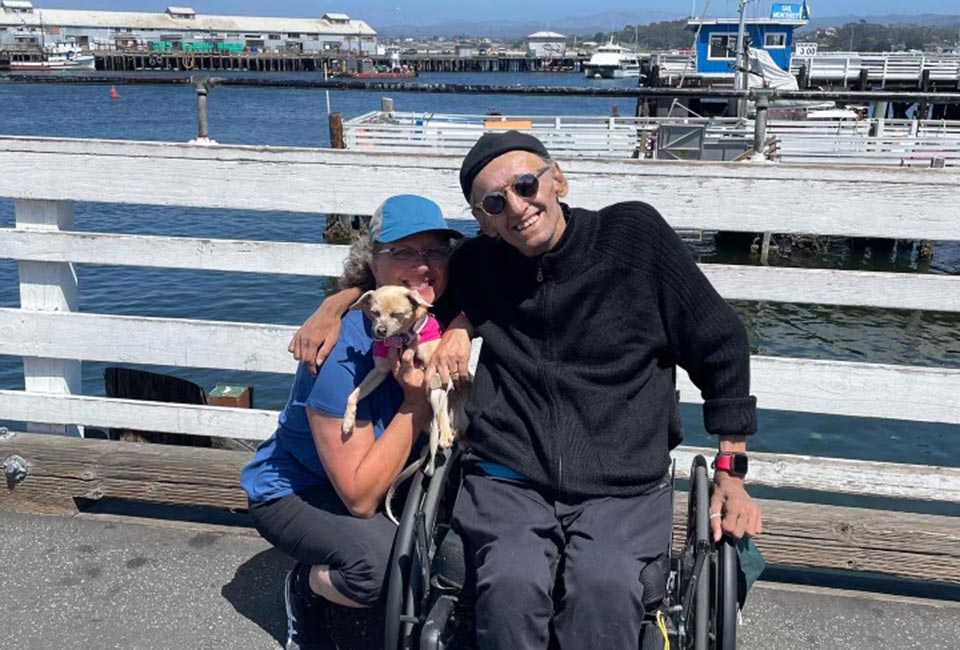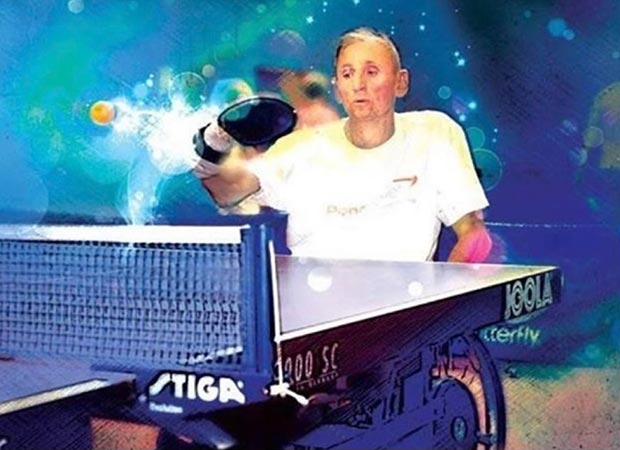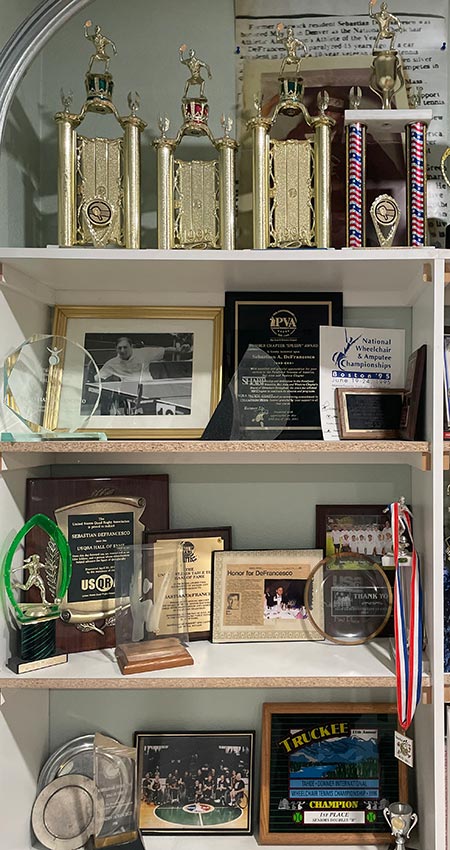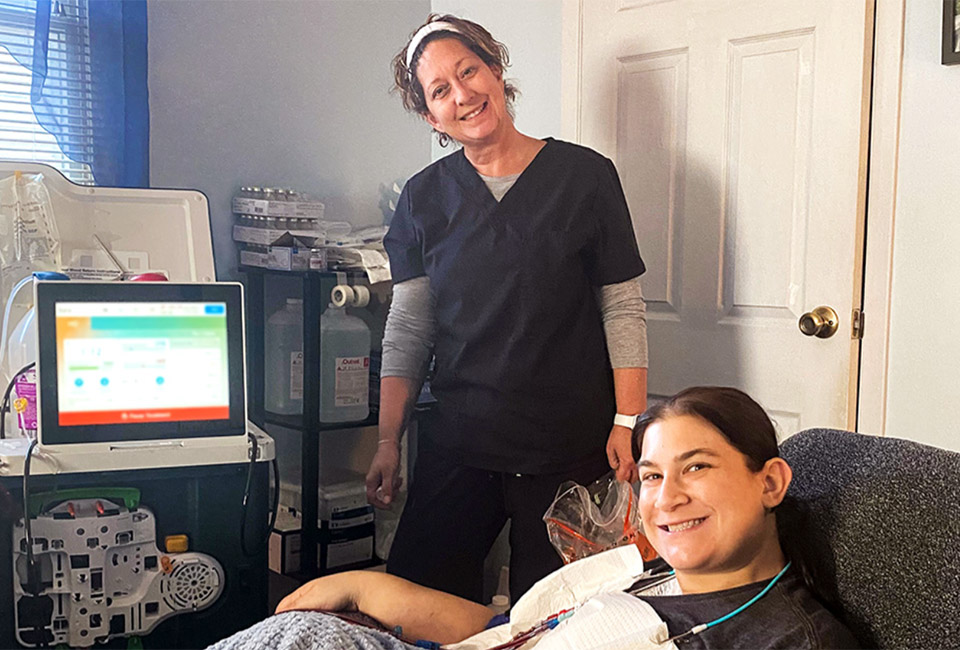Meet U.S. Army Vet and Wheelchair Athlete Sebastian

Summary
Although paralyzed since the 1970s, Sebastian has not let his disability or kidney failure slow him down. The Hall of Fame athlete and his wife and care partner Liz enjoy active lives, while managing Sebastian’s home dialysis with Tablo.
Sebastian and his wife and care partner Liz live in the California Bay Area, where they have been married for 27 years, and have three grown daughters. Sebastian, a championship table tennis and rugby player and coach, among many other sports and advocacy-related accomplishments, has had a challenging health journey. This includes a liver transplant 16 years ago, and a diagnosis of end-stage renal disease (ESRD) in 2021. Since February, the couple has managed his hemodialysis treatments at home, with the Tablo® Hemodialysis System, while maintaining active and fulfilling lives. What makes their story especially inspiring is that Sebastian is quadriplegic, and with Liz and their family by his side, his attitude, outlook and drive to help others have impacted so many.
While serving in the U.S. Army as an elite Special Forces soldier 45 years ago, stationed in northern Italy, Sebastian was in a motor vehicle accident that resulted in a paralyzing spinal cord injury. Back in the U.S., he was hospitalized for several months and underwent extensive and difficult rehabilitation, with independence as his goal. Today he is able to use both of his arms, one with limited strength, but without dexterity in his fingers.
“I’ve heard paralyzed people say, ‘it’s going to be so hard to accomplish things now because I can’t walk anymore.’ That has nothing to do with it,” says Sebastian. “My philosophy is, move on with life and enjoy it. It’s all mental. Life is about what you can offer,” he says. “Their life could be wonderful if they make it wonderful. Don’t ever give up. And keep fit as much as possible.”
Brave Health Journey with a Liver Transplant and Kidney Failure
Issues with Sebastian’s liver began in 1999, when he was diagnosed with hepatitis C. Over the next few years, he started experiencing symptoms of liver failure, and in 2003, was listed on the United Network for Organ Sharing (UNOS) liver transplant waiting list. He received a transplant in 2006—a surgically complex procedure, and the very first at the time for a quadriplegic. He had a long and arduous recovery, and was cured of hepatitis C in 2014.
Then, in early 2021, following a year of pandemic isolation, his health took another turn, and he started feeling horrible. In February 2021, he was admitted to the hospital with extremely high blood pressure, and issues with his donor liver and kidney failure.
“Sebastian has been on tacrolimus, a very strong anti-rejection medication for his liver transplant, for 16 years,” explains Liz. “The drug impacted his kidneys. He lost kidney function back when he had liver failure, and they never completely rebounded. With all the anti-rejection medication over the years, and then a methicillin-resistant Staphylococcus aureus (MRSA) infection in his blood and the strong antibiotics used to treat it, his kidneys decided to go.”
When his nephrologist told him his kidneys were failing, Sebastian wanted to postpone dialysis for as long as possible. He recalled his experience from 2003 when he was awaiting a donor liver and had to undergo hemodialysis in the hospital, in a room full of sick patients on big dialysis machines, and the headaches he would have during and after treatment.
Independence and Balance at Home
In November 2021, Sebastian’s nephrologist gave him the news that he would soon need to start dialysis, and based on he and his wife’s active lifestyle and their desire to remain independent, he recommended home dialysis with a new machine, Tablo. “He told us that we are perfect candidates for this, we need to do it. The machine is easy to use and user-friendly in comparison to other technology. He also said patients do better when they do dialysis at home,” says Liz. “Our nurse at the center also said she loves Tablo and its ease of use compared to other machines she has used.”
“He told us that we are perfect candidates for this, we need to do it. The machine is easy to use and user-friendly in comparison to other technology.”
The couple began three weeks of training at their local dialysis clinic in January of this year, and in mid-February, a Tablo console was set up in their home and Liz started managing all aspects of Sebastian’s treatment. She accesses his bloodlines via a catheter implanted in his chest. “Tablo gives us our day,” she says. “Sebastian rests or watches TV while I set up his two-hour dialysis [treatment time varies by patient; see the disclaimers at the end of this post], usually about 4:30 in the afternoon every other day, depending on what we have going on. I just do my thing with the step-by-step instructions on the touchscreen. Tablo doesn’t let you forget a step, and our nurse or tech is always available if I have questions or concerns. We get it done and then I usually make dinner for us, with a renal diet and protein shakes for Sebastian. He gets right up after his treatment, and usually does his hand cycle workouts.”
Prior to starting on Tablo at home, Sebastian hadn’t felt well enough to play his beloved table tennis in a long time, but now he enjoys playing again. “I feel pretty good, I play with able-bodied players and also those in wheelchairs,” he says. “It’s a wonderful sport, it has taken me around the world for championships a couple of times [see the Box below]. I have three beautiful daughters, a beautiful wife, a really nice life, and that’s what’s important to me.”
Liz also offers her advice to other patients and their loved ones who might be considering home dialysis. “I tell people in the online kidney disease community, including the Facebook support groups, that yes, I was terrified to do Sebastian’s dialysis at first. But don’t get freaked out, give yourself a bit of time, you can do this. You do the same routine each time,” she continues. “It’s also convenient. Dialyzing at home on Tablo allows you to schedule treatments around both of your schedules, not on the dialysis center’s schedule. In-center dialysis also didn’t fit our needs as Sebastian requires treatment more often than three days a week. With his delicate system and using Tablo, we’re able to pull less fluid more frequently. He’s never experienced cramping. Our lives are better now than before we started doing dialysis at home.”
As a full-time caregiver, Liz says that the key to staying balanced includes being active, which for her includes swimming, bike riding, Pilates, tai chi and choir singing. “I try to start every day with a workout, then I might run some errands. Then I help get Sebastian up, and we take our day from there, either doctor’s appointments, or dialysis or his weekly lab work that is required for his liver transplant. Being very closely connected to my husband, what helps him, helps me.”
 A Life of Athletic Accomplishment and Disabled Vet Advocacy
A Life of Athletic Accomplishment and Disabled Vet Advocacy
 Among his many athletic accomplishments, Sebastian is a U.S. Hall of Fame table tennis player, that he still enjoys playing (see image above). He was also assistant head coach of the National Wheelchair Rugby Teams for two seasons, was inducted into the Wheelchair Sports Hall of Fame and named the U.S. Olympic Committee’s Athlete of the Year in 1993. He competed in five Paralympic Games from 1984 to 2000 and won four Paralympic medals and eight National or Para Pan-American Games medals. Some of his many accolades are pictured here.
Among his many athletic accomplishments, Sebastian is a U.S. Hall of Fame table tennis player, that he still enjoys playing (see image above). He was also assistant head coach of the National Wheelchair Rugby Teams for two seasons, was inducted into the Wheelchair Sports Hall of Fame and named the U.S. Olympic Committee’s Athlete of the Year in 1993. He competed in five Paralympic Games from 1984 to 2000 and won four Paralympic medals and eight National or Para Pan-American Games medals. Some of his many accolades are pictured here.
He has also worked tirelessly lobbying Congress to improve hospitals and living arrangements for veterans, the homeless in particular, and to get businesses such as sports venues to follow the provisions of the Americans with Disabilities Act (ADA). He currently serves as president of the board of directors at the Bay Area and Western Chapter of the Paralyzed Veterans of America, among his many other roles focused on helping others.
Read more about Sebastian’s incredible story in this New Mobility article by Cindy Hall Ranii, “Sebastian DeFrancesco: Out of the Rabbit Hole, Into the Light” (article cited with permission).
Image at the top of this page: Liz and Sebastian with their dog Pebbles in Santa Cruz, CA; all photos on this page used with permission.
Interested in home dialysis with Tablo?
The Tablo Hemodialysis System is available for use both in-center and at home, through your provider. We may use the information you enter to reach out to your provider or other providers in your area, to let them know that you are interested in Tablo. By filling out this form and providing us your information, you agree to our Privacy Policy.
* Disclaimer:
The information, including but not limited to, text, graphics, images and other material contained on this website are for informational purposes only. No material on this site is intended to be a substitute for professional medical advice, diagnosis or treatment. Always seek the advice of your physician or other qualified healthcare provider with any questions you may have regarding a medical condition or treatment and before undertaking a new healthcare regimen, and never disregard professional medical advice or delay in seeking it because of something you have read on this website.
Tablo Hemodialysis System Disclaimer: Results may vary. Keep in mind that all treatment and outcome results are specific to the individual patient. Please consult your physician for a complete list of indications, warnings, precautions, adverse events, clinical results, and other important medical information. It is important that you discuss the potential risks, complications, and benefits of this product with your doctor prior to receiving treatment, and that you rely on your physician’s judgment. Only your doctor can determine whether you are a suitable candidate for this treatment.

